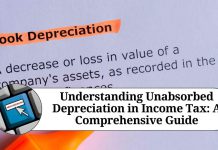Section 112 of the Income Tax Act deals with the taxation of long-term capital gains arising from the transfer of capital assets. In this blog post, we will delve into the details of Section 112 and understand its implications for taxpayers.
What is a Capital Asset?
Before we discuss Section 112, let’s understand what a capital asset is. A capital asset is any property held by an individual, whether movable or immovable, tangible or intangible, which is not held as stock-in-trade, raw materials or consumables. Some examples of capital assets include real estate, shares, bonds, jewelry, and artwork.
What is a Long-Term Capital Asset?
When a capital asset is held for more than 36 months, it is considered a long-term capital asset. However, for certain assets such as shares, listed securities, and units of equity-oriented mutual funds, the holding period required for them to be considered as long-term capital assets is only 12 months.
What is Long-Term Capital Gain?
When a taxpayer sells a long-term capital asset, any profit arising from such a sale is known as a long-term capital gain. The amount of long-term capital gain is calculated by deducting the cost of acquisition and cost of improvement (if any) from the sale price.
Taxation of Long-Term Capital Gain
Now, let’s discuss how long-term capital gain is taxed under Section 112 of the Income Tax Act. The tax rate applicable to long-term capital gain depends on the type of asset that has been sold.
For long-term capital gains arising from the sale of equity shares or equity-oriented mutual funds, the tax rate is 10%. However, this tax is not applicable if the total long-term capital gains from the sale of equity shares or equity-oriented mutual funds are less than INR 1,00,000 in a financial year.
For long-term capital gains arising from the sale of any other type of asset, the tax rate is 20%. However, taxpayers have the option to adjust the gains for inflation by using the Cost Inflation Index (CII). The CII is a tool used to adjust the purchase price of an asset for inflation, and it is updated by the government every financial year.
Introduction to Section 112
Section 112 of the Income Tax Act was introduced to provide provisions for the taxation of long-term capital gains arising from the transfer of capital assets. The section lays down the tax rates applicable to long-term capital gains and also provides for certain exceptions to taxation.
Understanding Capital Assets and Long-Term Capital Assets
As mentioned earlier, a capital asset is any property held by an individual, which is not held as stock-in-trade, raw materials or consumables. A long-term capital asset is a capital asset held for more than 36 months, or 12 months in the case of certain assets such as shares, listed securities, and units of equity-oriented mutual funds.
What is Long-Term Capital Gain?
When a taxpayer sells a long-term capital asset, any profit arising from such a sale is known as a long-term capital gain. The amount of long-term capital gain is calculated by deducting the cost of acquisition and cost of improvement (if any) from the sale price.
Taxation of Long-Term Capital Gain
The tax rate applicable to long-term capital gain depends on the type of asset that has been sold.
Taxation of Long-Term Capital Gain from Sale of Equity Shares and Equity-Oriented Mutual Funds
For long-term capital gains arising from the sale of equity shares or equity-oriented mutual funds, the tax rate is 10%. However, this tax is not applicable if the total long-term capital gains from the sale of equity shares or equity-oriented mutual funds are less than INR 1,00,000 in a financial year.
Taxation of Long-Term Capital Gain from Sale of Other Assets
For long-term capital gains arising from the sale of any other type of asset, the tax rate is 20%. However, taxpayers have the option to adjust the gains for inflation by using the Cost Inflation Index (CII). The CII is a tool used to adjust the purchase price of an asset for inflation, and it is updated by the government every financial year.
Use of Cost Inflation Index for Adjusting Gains for Inflation
The use of CII for adjusting gains for inflation is beneficial to taxpayers as it helps to reduce the tax liability. By adjusting the cost of acquisition for inflation, taxpayers can arrive at a more accurate capital gain figure, which will result in lower tax liability.
Exceptions to Taxation of Long-Term Capital Gain
There are certain exceptions to the taxation of long-term capital gains, such as the sale of a residential property, agricultural land, and certain bonds. In such cases, the gains may be exempt from tax or may be taxed at a lower rate.
Conclusion
Section 112 of the Income Tax Act lays down the provisions for the taxation of long-term capital gains arising from the transfer of capital assets. Taxpayers must be aware of these provisions and exceptions to ensure compliance with the Income Tax Act and avoid any potential tax liabilities. The use of Cost Inflation Index for adjusting gains for inflation is a useful tool for reducing the tax liability on long-term capital gains.
Read more useful content:
- section 145 of income tax act
- section 10e of income tax act
- section 9 of the income tax act
- section 94b of income tax act
- section 206aa of income tax act
Frequently asked questions (FAQs) related to Section 112 of the Income Tax Act:
Q: What is Section 112 of the Income Tax Act?
A: Section 112 of the Income Tax Act deals with the taxation of long-term capital gains arising from the transfer of capital assets.
Q: What is a capital asset?
A: A capital asset is any property held by an individual, which is not held as stock-in-trade, raw materials or consumables.
Q: What is a long-term capital asset?
A: A long-term capital asset is a capital asset held for more than 36 months, or 12 months in the case of certain assets such as shares, listed securities, and units of equity-oriented mutual funds.
Q: What is long-term capital gain?
A: Long-term capital gain is the profit arising from the sale of a long-term capital asset. It is calculated by deducting the cost of acquisition and cost of improvement (if any) from the sale price.
Q: What is the tax rate on long-term capital gains?
A: The tax rate on long-term capital gains depends on the type of asset sold. For long-term capital gains from the sale of equity shares and equity-oriented mutual funds, the tax rate is 10%. For long-term capital gains from the sale of other assets, the tax rate is 20%.
Q: Can I adjust the gains for inflation while calculating long-term capital gains tax?
A: Yes, taxpayers have the option to adjust the gains for inflation by using the Cost Inflation Index (CII).
Q: What are the exceptions to taxation of long-term capital gains?
A: There are certain exceptions to the taxation of long-term capital gains, such as the sale of a residential property, agricultural land, and certain bonds. In such cases, the gains may be exempt from tax or may be taxed at a lower rate.
Q: What is the benefit of using the Cost Inflation Index (CII)?
A: The use of CII helps taxpayers to reduce the tax liability on long-term capital gains by adjusting the cost of acquisition for inflation and arriving at a more accurate capital gain figure.
Q: Is there a limit on the total amount of long-term capital gains that are tax-exempt?
A: Yes, if the total long-term capital gains from the sale of equity shares or equity-oriented mutual funds are less than INR 1,00,000 in a financial year, no tax is applicable on such gains. However, this exemption is only applicable to long-term capital gains from the sale of equity shares or equity-oriented mutual funds.

































